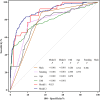Histogram of Apparent Diffusion Coefficient to Evaluate the Activity of Thyroid-Associated Ophthalmopathy
- PMID: 39835877
- PMCID: PMC11748203
- DOI: 10.1002/iid3.70131
Histogram of Apparent Diffusion Coefficient to Evaluate the Activity of Thyroid-Associated Ophthalmopathy
Abstract
Objective: This study aimed to evaluate the activity of extraocular muscles (EOMs) in patients with thyroid-associated ophthalmopathy (TAO) using turbo spin echo imaging. By analyzing tissue heterogeneity, apparent diffusion coefficient (ADC) histogram analysis offers enhanced insights into edema within the EOMs.
Methods: Eighty-eight patients with TAO were retrospectively evaluated and allocated into active (n = 24, clinical activity score [CAS] ≥ 3) and inactive (n = 64, CAS < 3) groups. The parameter values of the ADC histogram of EOMs were measured; the efficacy of ADC histograms in distinguishing between TAO activity and inactivity was assessed using receiver operating characteristic curves. Multifactorial logistic regression was used to determine active TAO predictors.
Results: The minimum, maximum, median, mean; and 1st, 5th, 10th, 25th, 75th, 90th, 95th, and 99th percentiles of the ADC histograms were higher in patients with active than that in participants with inactive TAO. The area under the curve (AUC) of the 10th percentile of the ADC histogram and the median distinguishing between active and inactive TAOs were both 0.791 (both p < 0.05), and the AUCs of the combined model of age, sex, smoking, and the 10th percentile in the ADC histogram were better than those of their individual models and the combined model of age, sex, and smoking (all p < 0.05). Smoking and male sex, along with the median > 1.26 μm2/s, entropy > 4.03, and standard deviation (SD) > 0.4 of the ADC histogram, were significant predictors of TAO activity, with odds ratios of 2.741 and 6.806, 5.070, 2.652, and 2.197, respectively (all p < 0.05).
Conclusion: ADC histograms provide a new method for distinguishing active from inactive TAO, and the 10th percentile enhances the clinical diagnosis of active TAO. In addition to male sex and smoking, an ADC histogram median > 1.26 μm²/s, entropy > 4.03, or SD > 0.4 may also predict active TAO.
Keywords: apparent diffusion coefficient; clinical activity score; extraocular muscle; intravoxel incoherent motion; thyroid‐associated ophthalmopathy; turbo spin echo.
© 2025 The Author(s). Immunity, Inflammation and Disease published by John Wiley & Sons Ltd.
Conflict of interest statement
The authors declare no conflicts of interest.
Figures


References
-
- Taylor P. N., Zhang L., Lee R. W. J., et al., “New Insights Into the Pathogenesis and Nonsurgical Management of Graves Orbitopathy,” Nature Reviews Endocrinology 16 (2020): 104–116. - PubMed
-
- Douglas R. S., Kahaly G. J., Patel A., et al., “Teprotumumab for the Treatment of Active Thyroid Eye Disease,” New England Journal of Medicine 382 (2020): 341–352. - PubMed
-
- Siakallis L. C., Uddin J. M., and Miszkiel K. A., “Imaging Investigation of Thyroid Eye Disease,” Ophthalmic Plastic & Reconstructive Surgery 34 (2018): S41–S51. - PubMed
Publication types
MeSH terms
Grants and funding
LinkOut - more resources
Full Text Sources

